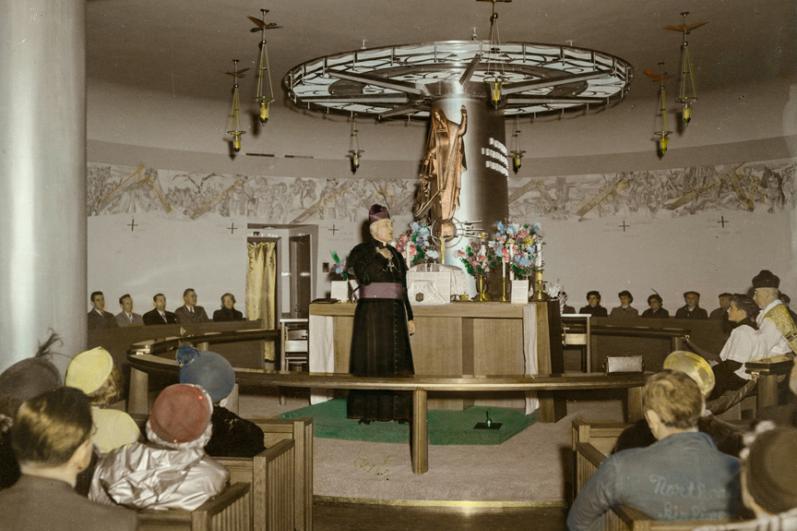Airport chapel dedicated 70 years ago
On Jan. 20, 1952 -- 70 years ago this month -- then Archbishop Richard J. Cushing of Boston dedicated Our Lady of the Airways Chapel at Logan Airport, now Boston Logan International Airport.
Over the previous decade, an increase in air travel necessitated an expansion of the airport, leading The Pilot to comment upon its "elaborate 'set-ups' of restaurants, lounges and observation decks and almost every conceivable convenience abound at the 20th century terminal." Although every possible need was seemingly accounted for, it occurred to Archbishop Cushing that one of the most important had been overlooked, and was able to secure a lease for space in the airport in which to place a chapel for airport employees and travelers.
Our Lady of the Airways was one of Archbishop Cushing's workers chapels, intended to reach people in their daily lives, and provide them an opportunity to attend Mass and receive the sacraments. But, as The Pilot reported at the time, the idea of such an initiative did not originate with the archbishop. It instead credits Pope Pius XI who had an oratory installed at a railroad station in Milan for travelers and railroad employees. Cardinal Emmanuel Suhard of Paris was also acknowledged for embracing this idea, sending his "working priests" into factories and other places of business "to counteract the forces of secularism" by making their faith more accessible to employees.
As Jan. 20 approached, it was announced that the day's events would be open to the public and nearly 5,000 people would visit the chapel on its first day. Five morning Masses were held at 7:30, 8:30, 9:30, 10:30 and 11:30 with Archbishop Cushing giving a sermon and distributing Communion at each.
The 10:30 Mass was primarily attended by members of the Guild of Our Lady of the Airways, those who supported the creation of the chapel, and notable civic dignitaries. Also present at this Mass was Cardinal Francis Spellman, Archbishop of New York, who arrived at the airport on his return from visiting U.S. service members in Korea and Europe. He shared with those present his impressions of Korea, the high morale of the U.S. troops, and revealed that many of the Chinese POWs he spoke with opposed communism.
At the time of its dedication, Our Lady of the Airways was referred to as "one of the most unusual chapels in the world. Located in a setting that reflects the swift pace of modern life, the unique chapel illustrates how well the Church in Boston is presenting age-old verities for contemporary needs."
The chapel was designed by architects Maginnis and Walsh whose work extended to many churches and buildings throughout the archdiocese. At the center of the chapel was placed a circular sanctuary, with a circular Communion rail around the outer edge, and was surrounded by a five-foot-wide circular aisle, which separated it from the first rows of pews -- pews which were arranged on all four sides of the sanctuary.
The altar was noted for its "striking simplicity," being made of walnut, and was "surmounted with a low tent-like tabernacle executed in finest metals and lined with the cedar from Lebanon."
The sanctuary was adorned with a statue of Our Lady of the Airways, which represented "Our Lady at the portal of the skies in her Assumption from earth's sphere below with the sun and moon at her feet." Three small planes could be seen circling the earth, upon which she looked down pointing with one arm, the other arm extended upward towards the heavens.
On the ceiling above the sanctuary were circular metal bands, ornamented in gold, silver, and blue, and suspended around the outside seven metallic doves representing the gifts of the Holy Spirit.
The chapel was completed with stations of the cross spaced along the exterior wall, a Hammond organ, and confessional. Understanding travelers' needs, two clocks were placed at "strategic position(s)" and airport loudspeakers could be heard within, though there was a separate volume control for those within the chapel.
Archbishop Cushing dedicated the chapel to the memory of pilots who lost their lives in World War I, World War II, and the Korean War. Living up to the words of Cardinal Spellman, who called him a "brave and progressive prelate," Archbishop Cushing took the opportunity to announce his plans for another workers chapel near Commonwealth Pier.
Our Lady of Good Voyage was dedicated later the same year, on Dec. 7, and would be followed by South Station's Our Lady of the Railways Chapel in 1955, and the Prudential Center's St. Francis Chapel in 1969. "Chapels of this nature," Archbishop Cushing stated, "are most necessary for many souls will be brought back to God and many will come closer to God."
At the time of opening, Our Lady of the Airways was intended to be open from 7 a.m. to 9 p.m. daily for those who desired a place of quiet repose, though Archbishop Cushing stated that it would soon be open 24 hours once the need became evident. Daily Mass was offered at 8:10 a.m., and Sunday Masses at 7:30, 9:30, and 11:30 in the morning, with Benediction of the Blessed Sacrament Sunday at 4:00 p.m. Father John D. Hausman, appointed the first administrator of the chapel and chaplain to airport employees, was conducting a survey of 3,000 airport employees to determine the most convenient times for them to attend Mass, after which the schedule would be adjusted accordingly.
In the 1960s, the chapel was moved to its current location, in Terminal C, to accommodate renovations to the airport. Mass remains open to the public and is celebrated Saturdays at 5 p.m. and Sundays at 9 a.m.
- Thomas Lester is the archivist of the Archdiocese of Boston.



















